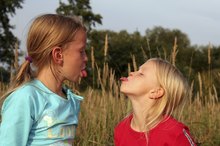Acting Out Behavior in a Three-Year-Old
While acting-out behaviors are common in most 3-year-old children, a calm, quick parental response discourages negative behaviors. Prevention and reinforcing positive behaviors are the best interventions; however, periodic acting-out is still inevitable, no matter how vigilant the parent. Become familiar with a variety of strategies to deal with problematic toddler behaviors 2.
Temper Tantrums
A temper tantrum occurs when an adult sets limits a 3-year-old dislikes. The tantrum is an expression of frustration and anger, as well as a means to manipulate. Respond to a toddler's temper tantrum by removing any sharp or dangerous objects from the vicinity. Ignore the child's tantrum as any attention, whether it be anger or laughter, will only reinforce this negative behavior.Once the child has calmed down, tell him you are proud of him for calming down. Empathize by stating that sometimes we all hear things we don't like; explain that, while you understand he was sad, throwing a tantrum is not good behavior. Over time, your child will learn that tantrums are an ineffective way both to manage his feelings and to manipulate you.
- A temper tantrum occurs when an adult sets limits a 3-year-old dislikes.
- The tantrum is an expression of frustration and anger, as well as a means to manipulate.
Biting
Define Deviant Child Behavior
Learn More
To a toddler, biting is an expression of frustration, a way to communicate or a self-stimulating habit. Teach your child to express feelings in a way other than biting such as expressing feelings verbally or drawing a picture of how she feels. Look for signs your child is becoming frustrated and help him label his feelings by making statements such as, "It looks like you are getting mad."
Hitting
Frustrated toddlers lash out physically because they are ineffective problem solvers; calmer means of resolving problems are not obvious to them. If your child is hitting another child, remove the victim from the situation immediately. Put the child in a time-out; alone time is likely to help her calm down. Parents need to identify role models in the child's environment who could be modelling aggressive behaviors and work with the family as a unit to manage anger without physical aggression.
- Frustrated toddlers lash out physically because they are ineffective problem solvers; calmer means of resolving problems are not obvious to them.
Back-Talk
Autism Symptoms in an 8-Year-Old Child
Learn More
A 3-year-old child who is learning to express his independence often engages in back-talk when he is expressing disagreement with parental rules. Ignore back-talk to reinforce your power over the toddler; arguing with the child sends an inadvertent message that your limits are negotiable. Praise your child during moments when he follows parental rules and limits without back-talk. Your child will eventually learn that a positive response garners praise, and back-talk is an ineffective waste of his time.
- A 3-year-old child who is learning to express his independence often engages in back-talk when he is expressing disagreement with parental rules.
Related Articles
References
Writer Bio
Brenda Scottsdale is a licensed psychologist, a six sigma master black belt and a certified aerobics instructor. She has been writing professionally for more than 15 years in scientific journals, including the "Journal of Criminal Justice and Behavior" and various websites.









